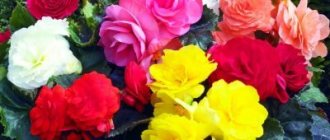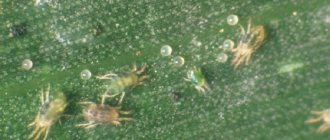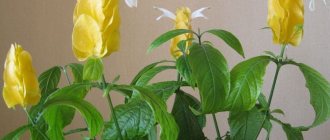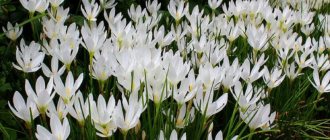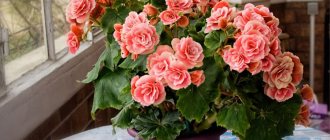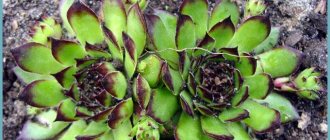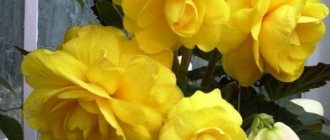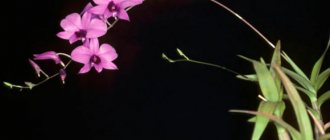Peculiarities
Terry begonia is especially common in the subtropical zone. Its homeland is considered to be Africa and India, from where it was actively imported to Europe in the 17th century to decorate the flower beds of noble people. Since then, various varieties of this flower have been selected, which can take root well in the climatic conditions of the temperate zone of Russia. The main feature of this plant is its appearance. Begonia buds are very reminiscent of rose flowers - just as multi-layered and delicate.
However, terry begonia, unlike most varieties of roses, is less picky in terms of care, so many flower garden owners prefer this particular flower for growing.
The plant is distinguished by a neat compact bush, as well as large buds, whose petals have a terry edge. The flowers themselves can have different shades depending on the variety. Traditional classic varieties, as a rule, have red, white or yellow bud colors, while newer ones offer gardeners to decorate their garden with pink or orange begonias. At the same time, the color of the petals may be uneven, which, in combination with the terry edge, makes the appearance of the bush even more interesting. The leaves of the plant themselves are large in size and have carved edges, which is an additional decorative highlight of the plant. Thus, the buds look more delicate and fragile against their background. Some begonia varieties have leaves that have a reddish tint or veins.
This flower is often actively used by designers to create beautiful flower arrangements and a festive mood at major celebrations.
As begonia grows, two unisexual flowers are formed - male and female. It is the male buds that have a terry edge and perform the main decorative function, while the female buds are necessary for further propagation of the plant - they contain a seed pod. Most varieties are planted in open ground at the end of spring, when the soil has already warmed up sufficiently. The plant blooms all summer, and some varieties of begonia, for example, ever-flowering ones, can delight the owner with their flowering until the onset of winter, and in regions with a warm climate - all winter. Begonia can be grown not only in open ground, but also at home.
Depending on the variety, terry begonia can differ in the structure of the root system into the following types:
- tuberous - more suitable for planting at home;
Planting in open ground
Fimbriata grows well in flower beds. Maintenance there is even easier than in a potted plant - there is less chance of the underground part rotting from overwatering, the plant can better withstand the heat in the fresh air.
Planting is done when the soil warms up to 15° C. In the central zone this is usually June, in the south - the end of May.
Tuber selection
The diameter of the tuber for planting in open ground is at least 4 cm; begonias that are too young are not suitable for a flower bed. The surface should be smooth, without signs of damage.
If the tuber had to be divided or treated - cut out rot, dried areas, it is better for Fimbriata to spend the season on the windowsill. It can be planted in open ground no earlier than next summer.
Soil requirements
The soil needs to be loose, permeable, with a neutral reaction, well structured, that is, when it gets wet, it should not stick together, and when it dries, it should not turn into stone. On loams or chernozems, it is recommended to fill the holes with a planting mixture - mix the top fertile layer with sand, peat, and leaf humus.
Fimbriata is a medium-sized begonia. The distance between bushes or to other crops should be at least 25-30 cm.
Landing rules
By the time it is moved into open ground, Fimbriata usually blooms; the operation must be done very carefully.
Landing algorithm:
- Prepare the holes, fill them with the prepared soil mixture, and water them.
- Remove seedlings from containers.
- Plant at the same depth as in the pot.
- Pour in Fitosporin solution.
- Mulch with sand or neutral peat.
Description of the species yellow begonia
Yellow begonia is known by many names: double yellow begonia, tuberous yellow begonia - only the most common of them and are based on the appearance and structure of the plant's root system. In general, yellow begonia is a semi-shrub plant up to 45-50 cm high with recumbent shoots. The leaves reach a length of up to 20 cm, a width of up to 15 cm. The diameter of the flowers is up to 4 cm, however, it seems to be much larger, since the flowers are collected in large inflorescences. The flowers are orange-yellow, which gives the species its name.
Begonia ampelous yellow (also known as yellow begonia Pendula) has earned great popularity, as it is grown not only indoors, but is also widely used to create colorful flower arrangements, design flower beds and flower beds. Very often it is used by florists to decorate special events, weddings, for example. Its leaves and flowers are almost the same size - 10-20 cm; Pendula blooms from May to October.
Diseases and pests
Common diseases characteristic of the terry variety are:
- Gray rot, which appears from an excess of moisture in the room and lack of heat. In this case, the plant becomes covered with mold, which can be dealt with by spraying with special preparations. The affected areas of the flower should be carefully removed. It is also important to regularly ventilate the room if the begonia is kept indoors.
- Powdery mildew. The cause of this disease is frequent temperature changes, the presence of drafts and excess moisture. Outdoor plants are at risk. The disease is treated by treating with fungicides.
In addition to diseases associated with improper living conditions, pests also pose a danger . Among them are often found:
- A spider mite that entangles a plant and feeds on its juices. To get rid of a tick you will need a soap solution.
- Aphid. It also often attacks terry begonia, and getting rid of it is quite difficult - you will need to treat the flower with insecticides every day until the pests completely disappear.
Caring for yellow begonia
Caring for begonia, which is grown at home, is not at all burdensome and does not require special skills. It is only important to create partial shade for it, protect it from direct sunlight and ensure the air temperature is within 15-17 C.
Regarding watering, it should be moderate; begonia does not tolerate stagnation of water and this leads to rotting of the root system. The same result can be expected if there is not enough water, so you need to regularly check the condition of the soil and water it as it dries out. Often, but little by little.
Being a lover of moist air, but afraid of water droplets getting on the leaves, begonia will feel great on a tray with wet pebbles or expanded clay.
Given the growth rate, annual replanting is mandatory for begonias. The soil should be nutritious and, if possible, acidic. When replanting, the procedure of pruning the plant is also carried out - pruning.
Possible problems during cultivation
Terry begonias can be susceptible to diseases and pests. The most resistant to them are plants from the ever-flowering group, which get sick mainly when the conditions of proper care are violated.
Also find out why begonia leaves dry out.
Diseases
If care and conditions of detention are violated, the following diseases may appear:
- Powdery mildew. Such a nuisance can be identified by a white powdery coating on the leaves. The disease is provoked by temperature fluctuations, drafts and excessive humidity. Fungicidal preparations “Saprol”, “Bytleton”, “Topaz” will help to cope with the problem. Treatment with sulfur powder gives good results. They sprinkle it on the plant and put a plastic bag on top.
- Gray rot. The appearance of the disease can be detected by a grayish coating on the leaves of this indoor flower. Humid and cold indoor air and lack of ventilation contribute to the appearance of gray rot. Affected leaves should be removed and chemicals such as Fundazol should be used.
- Bacterial spotting. Signs of the disease are the appearance of watery, glassy spots on the back of the leaves, which become dark brown over time. Unfortunately, the disease has no cure. The plant should be disposed of along with the soil, and the pot should be disinfected. To prevent the appearance of bacterial spotting, treatment is carried out with a 0.5% solution of copper oxychloride. This treatment is then repeated after 14 days.
Pests
Terry begonia can be attacked by the following pests:
- Spider mite . The presence of a pest is signaled by the presence of a thin cobweb and white-yellow blotches on the leaves, especially on the reverse side. To destroy the pest, the plant is washed with a sponge soaked in a soapy solution, and the chemicals “Aktellik” and “Fitoverm” are used. Treatment is carried out 2-3 times every week.
- Aphid . Ants are often the cause of aphids. To eliminate this problem, use chemicals containing pyrethrum or garlic infusion. Treatments are carried out until the aphids completely disappear.
- The false shield is soft . Signs of its appearance are discoloration and deformation of the leaves, a sugary coating, and poor begonia color. The false shield is an insect up to 5 mm, transparent with a yellowish coating. Its larvae drink the sap of the plant. If this pest is identified, you can treat it with garlic infusion, or you can use chemicals like Actellik.
- Whitefly . A small insect that looks like a small whitish butterfly. It affects plants in greenhouses and winter gardens. When it appears, the plants are sprayed with chemicals such as “Confidor”.
Different groups of begonias have terry varieties, which differ slightly in care. If you comply with all the necessary conditions for growing, then terry begonia will certainly delight you with its beautiful color.
Reproduction of yellow begonia
It is not difficult to propagate yellow begonia and methods of dividing the bush, using live bait, leaves, and sowing seeds are suitable for this. Cuttings cut from the stem are pressed into moist soil and rooted directly in the pots.
Seeds are sown between December and March, and disappear in the next 10-15 days. When the seedlings grow a little, they are packed into pots, and in the middle of summer they already bloom profusely.
If tubers are used for propagation, then it is advisable to plant them between February and June. The tubers are half-filled with moist soil, and the tray is placed in a dark, cool place. When the shoots sprout, the tray is moved to a warm place with enough light, and the tubers are completely covered with earth.
First meeting
Terry begonia belongs to the extensive genus Begoniaceae, which is native to the hot subtropics of Africa, South America and India. Plants of this genus were domesticated back in the 17th century; since then, the species and varietal diversity of begonias has exceeded tens and thousands.
Terry begonia is a compact, neat bush with beautiful carved leaves of reddish or green color and large flowers of bright colors - white, red, pink. yellow, orange. This type of begonia received its special beauty and its name thanks to the terry border on the flower petals.
Depending on the root system, tuberous and bush terry begonias are distinguished, and based on the height and growth pattern of the bush, they can be divided into ampelous and ordinary bushes. Almost all types of begonias produce two types of flowers - male and female. The former are highly decorative, while the latter are simple, non-double and small, but it is in their place that a seed pod will form over time.
The flowering period of these plants usually lasts throughout the summer, although some varieties, such as double everflowering begonia, may continue to bloom into autumn and even winter.
You can grow terry varieties of begonias both indoors and on the balcony, veranda or in the garden. The main thing is to choose the most comfortable place for them that meets all the requirements of agricultural technology.
Home care
After planting, proper care of the plants should be established.
Top dressing
During the active period, and especially during the flowering period, terry begonia is fed with complex fertilizers for flowering indoor plants 1-2 times every 30 days. They can be purchased at any store. In winter, feeding should be stopped.
Watering
When a warm period begins, the flower needs abundant moisture without stagnation of water. Watering is carried out at least 2 times every 7 days, but without overflowing or stagnant water. During the cold period, watering for wintering varieties is reduced to 1 time every 10 days, since growth and development slows down during this period. For irrigation use settled water at room temperature.
Important! During the heating season, make sure that the soil does not dry out completely due to being close to heating devices.
Flower pruning and replanting
As the begonia grows and develops, it is transplanted into a new pot every 1–2 years, when the plant grows and the old container becomes cramped. Spring is a good time for replanting.
Tuberous terry varieties are not pruned. This procedure causes the plant to branch and bloom more profusely, but the flowers themselves become smaller. Ampelous varieties are pinched to help them quickly master the pot.
Terry bush begonia requires periodic pruning. With its help, the bush is given a beautiful shape. To carry out pruning, use a well-sharpened knife. When the young plant reaches 10 cm, it is necessary to pinch the top so that this indoor flower begins to form side shoots and is lush. When the side shoots reach 12 cm, they should also be pinched.
Ever-blooming varieties do not need pruning, but when they eventually stretch out and expose the stem, they are renewed by cuttings. Sanitary pruning is always done - diseased, dry and damaged parts are removed.
Rules for caring for begonias
Begonias are not too capricious, although they have such a reputation. If you provide them with suitable conditions from the very beginning, the plant will respond with abundant flowering and a minimum of requirements.
It is best to grow terry begonias in clay pots with drainage holes at the bottom. Clay is a porous material that will provide sufficient access of fresh air to the roots of the plant.
Recommendation! New clay pots should be soaked in water for several hours or a whole day before first use.
Begonias will require loose, nutritious soil with a slightly acidic reaction (pH 5.5-6.5). You can create a suitable mixture yourself. To do this, just mix:
- 2 parts leaf soil;
- 1 part river sand;
- 1 part humus;
- 1 part peat.
Begonia propagation
Depending on the type of terry begonia, it can be propagated in several ways:
- cuttings;
- seeds;
- sections of tubers.
The last method, as it is not difficult to understand, is available only for those terry begonias that belong to the tuberous family.
Reproduction by cuttings
This method is considered the simplest and most common; it is suitable for all types of begonias. The best time to take cuttings is early spring. Using a sharp knife, cut cuttings up to 10 cm long from the plant, remove the lower leaves and place them either in a container with water or directly in the soil.
Tuberous begonia and its subspecies
Tuberous begonia (Begonia tuberhybrida) is one of the species of the large begoniaceae family. This is a southern guest from the tropics, who in the 19th century came to Europe and settled permanently. The cultivation of begonia and its selection originate in Belgium, which, since 1867 and to this day, has been the leader in the cultivation of this plant.
Thanks to the work of breeders, double varieties with large and small flowers appeared, having warty, folded, jagged, fringed and dissected petals, flowers with a contrasting border and various new shades.
Tuberous begonias are herbaceous perennial plants in which a tuber with fibrous roots is formed below the root collar. The tuber of an adult plant is round-flat, irregular in shape, about 5 cm in diameter, with a small depression on one side. Renewal buds are formed on the tubers.
The stem is fleshy, juicy and quite fragile, green in color (may be slightly reddish), all covered with thin fibers. It grows on average from 15 to 35 cm. Tuberous begonia branches weakly.
The leaves are asymmetrical in shape with a pointed tip, located on long pubescent petioles. They have well-defined serrated venation. Anthocyanin pigments are present in the dark green color of the leaves of some varieties.
The flowers are heterosexual, form small inflorescences (up to 5 pieces). They are very diverse in their form. In addition to simple ones, there are terry and semi-double ones of various colors. The size of the flowers (depending on the variety) varies from 2 to 20 cm.
Yellow-orange small seeds (they are slightly larger than those of the ever-flowering begonia) are hidden in the fruit - a triangular winged capsule. Terry varieties often do not produce fruit.
Currently, tuberous begonias are usually divided into the following groups:
- Small-flowered (Multiflora) - flowers can be simple or double, the size of which is 2-5 cm.
- Medium-flowered (Multiflora maxima and Bertini) - flowers from 5 to 10 cm.
- Large-flowered - the size of flowers is from 11 to 20 cm, they can be simple with warty, folded, giant and bordered petals, as well as double with fringed, peony-shaped, rose-shaped, narcissus-shaped and camellia-shaped forms.
- Ampelous - flowers ranging in size from 2 to 8 cm are simple and double, shoots are long from 25 to 100 cm.
And now we invite you to get acquainted with some of the many varieties. You will see what kind of tuberous begonia there is, the photos will objectively illustrate this.
- Bouton de Rose - pink-shaped begonia, flower diameter on average 15 cm, white petals with a rich pink border, in the middle are collected into a bud resembling a rose.
- Double - variety series of peony begonia, flower size 10-12 cm, comes in several shades of red, white, pink, orange, yellow.
— Daffodil Salmon is a striking representative of the narcissus begonia of amazing salmon color and unusual shape.
— Camelia Flora pink-white — camellia-shaped begonia of an unusual red color with a white tint along the edges, has the peculiarity of blooming even in a heavily shaded place.
— Fimbriata is a fringed, highly double variety series, the flowers are very reminiscent of carnations, the colors are pink, orange, red, white, yellow.
— Crispa Marginata is a variety series with folded flowers with a wavy edge, the flowers are yellow with a red border and white with crimson (10-12 cm in diameter).
— Cristata yellow is a representative of warty varieties, a simple yellow flower about 11 cm, the vein in the center of the petal has a fringe-like outgrowth.
— Multiflora Maximum is a medium-flowered variety series with double flowers of white, yellow, dark pink, red and dark red colors, about 7 cm in diameter.
